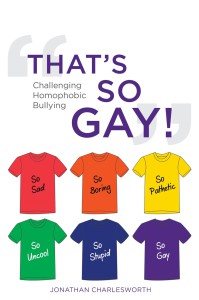Jonathan Charlesworth is the Executive Director of the multi-award winning charity Educational Action Challenging Homophobia (EACH), UK, and author of That’s So Gay! – Challenging Homophobic Bullying. With over thirty years’ teaching and training experience, he regularly delivers training and consultancy on homophobic bullying, harassment and crime to schools, colleges, universities, and the police service. In honour of LGBT History Month, Jonathan talks about how his book can help schools to address homophobic bullying, with examples of how some schools have already put strategies from the book into practice.
Bullying is something which quite rightly the education system and media keeps foregrounded in  the news and whilst I’ve never met a teacher or a youth worker who doesn’t know what to do about racist, faith-based or disablist bullying, I’ve met too many teachers who remain unconfident about challenging homophobic bullying.
the news and whilst I’ve never met a teacher or a youth worker who doesn’t know what to do about racist, faith-based or disablist bullying, I’ve met too many teachers who remain unconfident about challenging homophobic bullying.
February is LGBT History Month and very possibly your school, academy or college is looking for dynamic ways to mark this by looking at issues past and present which have shaped our understanding of them.
If you’d welcome feeling either more confident about supporting a young person who comes out as gay or better able to challenge homophobic name-calling and bullying then That’s So Gay! – Challenging Homophobic Bullying will help you to do just this.
Bradley Stoke Community School wanted to raise awareness about the word ‘gay’ being a political antidote to the pathological and criminal connotations attached to ‘homosexual’, so 30 teachers wore t-shirts for a week with GAY on the front and Good As You on the reverse. The teachers explained to interested pupils (who all were!) how gay came to be the adjective to more respectfully describe gay people than homosexual during the American civil rights marches of the 1960s and 1970s. Jonathan Charlesworth was then invited to speak to designated year groups in an interactive session about changes in the law for gay or trans people effecting positive changes for all society. Ofsted highlighted the school’s approach to this equalities issues citing it during inspection as an example of best practice.
Enthusiastically welcomed by national experts in the field of education and bullying as well as teachers and youth workers everywhere, That’s So Gay! tackles head on those questions you’ve either asked yourself or heard raised by colleagues, friends or acquaintances who work with young people.
Adopting a down-to-earth approach the book addresses the most frequently asked questions including:
“I work in a faith school. How can I promote empathy concerning issues of sexuality without going against the teachings of my religion?
“Will I need to discuss any sexual activity in which a pupil has engaged if I’m to talk to them about coming out as gay?”
“Isn’t secondary school the place to introduce these issues where other adult issues are discussed?”
Wyedean School in Gloucestershire created the campaign “It’s not gay!” showing historical pastimes like Morris Dancing or out of date concepts and technology such as music boxes or the Sony Walkman. Beneath each image were the words “It may be old fashioned but it’s not gay!
Every aspect of coming out and homophobic bullying is covered from knowing what to say and how when you’re the person to whom a student comes out, to advising them on positive strategies going forwards: helping them enjoy life whilst staying safe as they do. If things don’t go well and your young person is experiencing homophobic name-calling or bullying That’s So Gay! takes you step by step through how to support the individual and what your whole school or college can do to effect purposeful, constructive change to prevent homophobic bullying happening in the future.
Still looking for inspiration on dealing with homophonic name-calling or bullying? Why not try some of these ideas which have been successfully used by schools Jonathan has worked with in the past:
- Set pupils the challenge to ‘use another word’ when they hear peers describing things as ‘gay.’
- Conduct an attitudes survey amongst staff and pupils to reveal levels of prejudice based name-calling or bullying, including both teacher’s and pupil’s experiences.
- Ask year 11 pupils to write to their Year 7 (12 year old) self and give them tips as to how to be resilient in the face of harassment or bullying, where to go for help and from whom.
Jonathan Charlesworth is the Executive Director of the charity Educational Action Challenging Homophobia (EACH), currently working on a national Government Equalities Office and Department for Education programme to stop and prevent homophobic, biphobic and transphobic bullying. He has over thirty years’ teaching, training and consultancy experience: regularly working with schools, colleges, universities and the Criminal Justice System to help them challenge homophobic or transphobic bullying and crime.
That’s So Gay! Is published by Jessica Kingsley Publishers priced £17.99